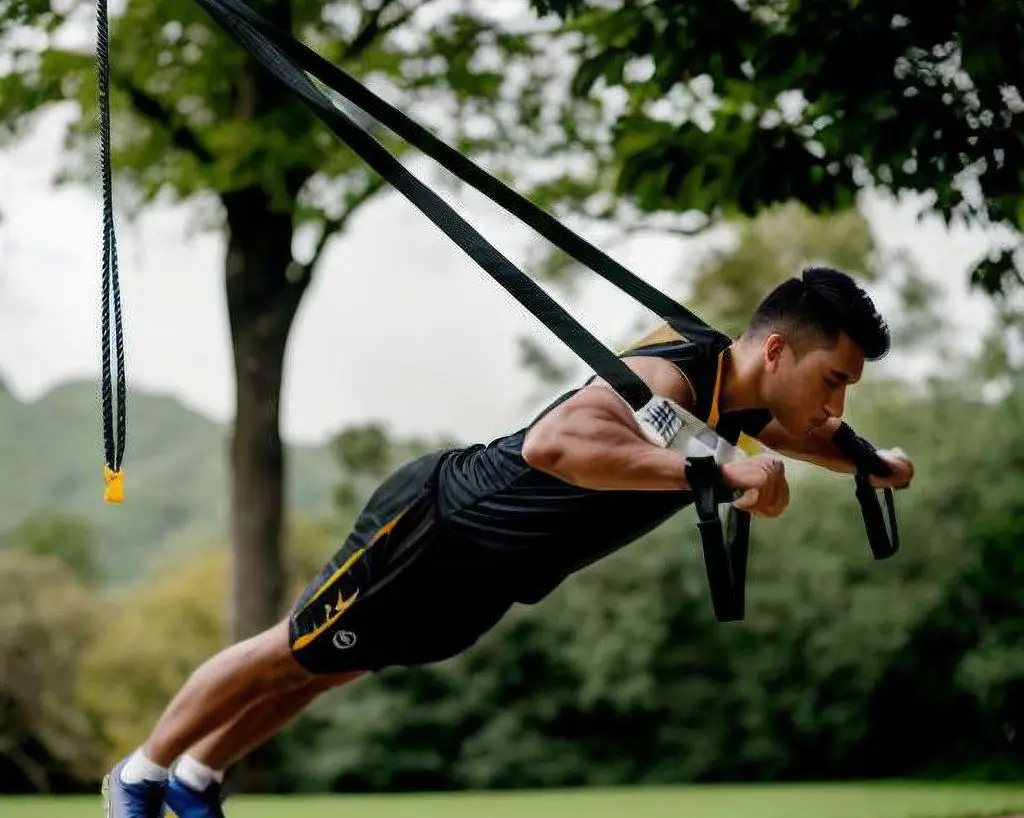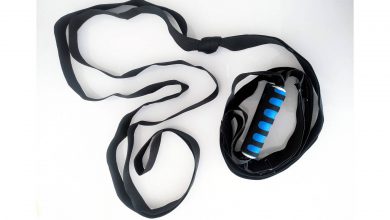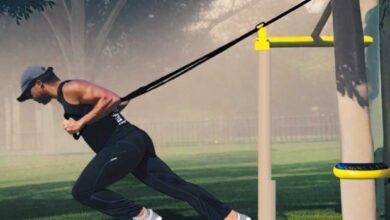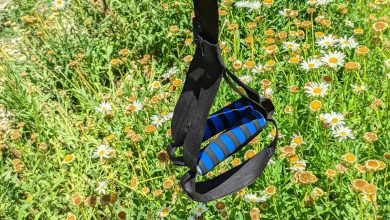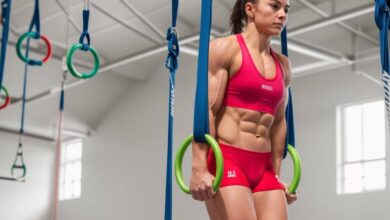Chest is one of the main muscles in the human body. A lot of upper body activities directly or indirectly engage chest muscles. Chest muscles are big and require training at various angles. Using TRX to target chest muscles, we can perform various TRX chest exercises to improve strength, hypertrophy, and fitness measures.
TRX chest exercises can be performed by individuals of all fitness levels–from beginners to advanced athletes. The beauty of the TRX is that it allows for a wide range of modifications based on an individual’s skill level, making it an excellent tool for progression. TRX chest exercises primarily focus on the chest muscles while also engaging the triceps, shoulders, and core, resulting in a full-body workout.
Some of the most popular TRX chest exercises include chest press, fly, push-up, and atomic push-up. These exercises can be performed in various positions, such as standing, kneeling, and most of them can be performed with single anchor point and double anchor points. We will go over all variations of TRX chest exercises and explain how to perform them in detail.
Chest muscles are big. So, to exercise them properly, it is common to train upper-chest, mid-chest and lower-chest muscles separately at different angles.
Table of Contents
1. TRX Chest Press
TRX chest press or TRX push-up is the most common TRX chest exercise. Since chest muscles are big, they need more challenge than small muscles. For hypertrophy purposes, aim for 8–12 repetitions and 4–5 sets. Here is how to do TRX chest press:
- Hold TRX handles and face away from the anchor point.
- Lean forward and find an appropriate angle that imposes sufficient pressure on your chest muscles.
- Arms are in extended position, and the entire body is straight.
- Bend elbows and slowly decline until handles are at chest level. Inhale during this phase.
- Push up and exhale simultaneously until you reach the initial position.
To benefit the most from this movement, while arms are extended, tuck hands close to each other. This extra move allows a broader range of motion and engages other parts of chest muscle.
Determine the level of pressure by adjusting the angle of body to the earth. The more you lean forward, the more challenging it becomes. You can also step one leg forward to benefit from the intelligent weight technique.
TRX Chest Press Variations
The standard grip position in TRX chest press is overhand grip. However, we can add variations to this exercise by trying neutral and twisting grip. In twisting grip, start with overhand grip while arms are extended, and as you descend, turn your hands into neutral grip and vice versa.
We can perform TRX push-up with TRX single anchor point or TRX double anchor point. Using double anchor points dramatically changes this exercise and makes it even more challenging.
TRX Push-up Feet in Strap
TRX push-up feet in strap is another variation of this exercise. In TRX push-up feet in strap, instead of holding handles, we put hands on the ground like a regular push-up and put feet in TRX foot cradles.
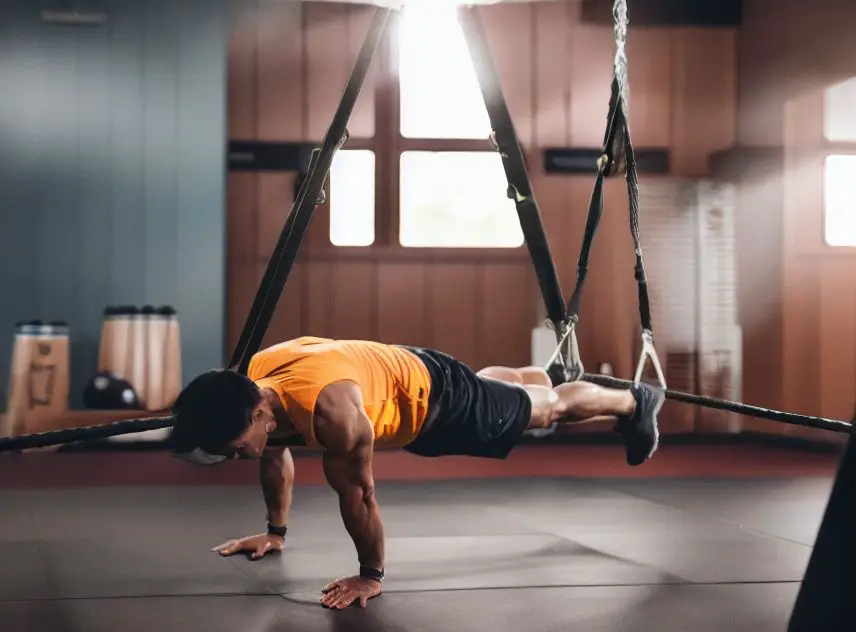
Please note that some of the links on this website are affiliate links, which means that we may earn a commission if you click on the link and make a purchase. This won’t cost you anything extra.
Revolutionize your push-ups with Parallettes Pushup Bars! Elevate above the floor for optimal range of motion and perfect your form with ease. Crafted from solid steel, these parallettes allows to go deep in TRX chest press feet in strap. Grab your Parallettes Pushup Bars now and take the push-up challenge head-on!
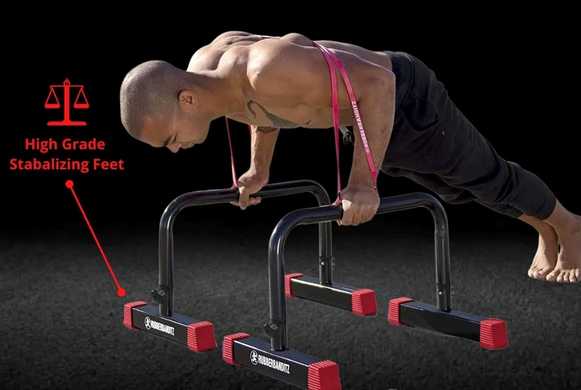
TRX Single Leg Chest Press
Body positioning in TRX single leg chest press is like normal TRX chest press, except one foot is lifted off the ground. This exercise increases instability, so you must always balance your pushing power between left and right chest muscles. It also more engages core muscles.
Common Mistakes During TRX Push-up
- Hold elbows inline with chest. Dropping elbows close to both sides of the body will shift the tension from chest muscles to other parts such as shoulders or triceps.
- Find your suitable position and angle before you start the set. Changing body position during the set can remove the weight from the chest muscle and reduces the effectiveness of the exercise. However, advanced trainees can make micro-adjustments by implying intelligent weight technique without losing focus from chest muscle.
- The angle between the arm and torso is important in this exercise. Bringing your hand upward or downward puts emphasis on other parts of the chest muscle, such as the upper chest or lower chest. Maintain a steady angle during the exercise to ensure you properly target the muscle. Doing so requires some body awareness, which can be gained through experience.
- Due to the composition of this exercise, sometimes suspension straps rub against arms. Changing body position or arm position relative to the anchor point can prevent skin chafing. You may also use arm sleeves to protect your skin against rub.
Padded REGUL8R Compression Sleeves – the ultimate blend of comfort and protection. Engineered with silky polyester-spandex, they stay in place with a non-slip silicon strip. Embrace cozy compression to shield your arms from abrasions. Elevate your performance and style!
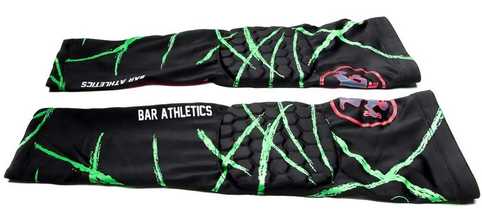
TRX Push-up vs Regular Push-up
Both TRX push-ups and regular push-ups are effective exercises for building upper body strength, but they differ in their approach.
TRX push-ups are performed using suspension training equipment, such as the TRX system. This equipment allows for greater instability, which challenges the core muscles to work harder to maintain stability throughout the exercise. During a TRX push-up, the hands are placed on the handles of the suspension straps, and the feet are positioned behind the body. The arms are extended to lower the body towards the ground, then pushed back up to complete the repetition.
Regular push-ups, on the other hand, are performed with the hands placed on the ground shoulder-width apart and the feet together. The body is then lowered towards the ground by bending the arms, until the chest is just above the floor. The body is then pushed back up to complete the repetition.
Overall, both exercises are great for building upper body strength, but TRX push-ups offer a unique challenge due to the unstable nature of the suspension equipment. With TRX, we can adjust the level and angle of pressure in various ways.
TRX Push up vs Chest Press
Traditionally, push-up and chest press are two different exercises. Chest press is a weight training exercise, but push-up is bodyweight exercise that requires putting hands on the ground and pushing your body up. However, since TRX is a bodyweight exercise, those terms are used interchangeably, and we may use TRX chest press to refer to the same movement.
Which Muscles Work in TRX Chest Press?
The primary muscles worked during the TRX chest press are the pectoral muscles, which are located in the chest. These muscles are responsible for adduction and internal rotation of the arms, which is the movement required to bring the arms towards the center of the body during the exercise. During the TRX chest press, the pectoral muscles contract, thereby activating and strengthening these muscles.
In addition to the pectorals, the triceps also play a significant role in the exercise. The triceps are located on the back of the upper arms and handle elbow extension. During the TRX chest press, the triceps work to straighten the arms and provide additional pushing power, helping to move the body away from the anchor point.
Apart from the chest and triceps, the shoulders also come into play during the TRX chest press. The deltoid muscle, which is located on the top of the shoulder, is responsible for shoulder abduction, flexion, and extension. During the TRX chest press, the deltoids help stabilize the shoulders and assist in moving the arms away from the body.
Finally, the TRX chest press also engages the core muscles, particularly the rectus abdominis and the obliques. Since the exercise requires you to maintain stability while performing the pushing movement, the core muscles engage to keep the body aligned and prevent it from sagging or rotating.
2. TRX Single Arm Push-up
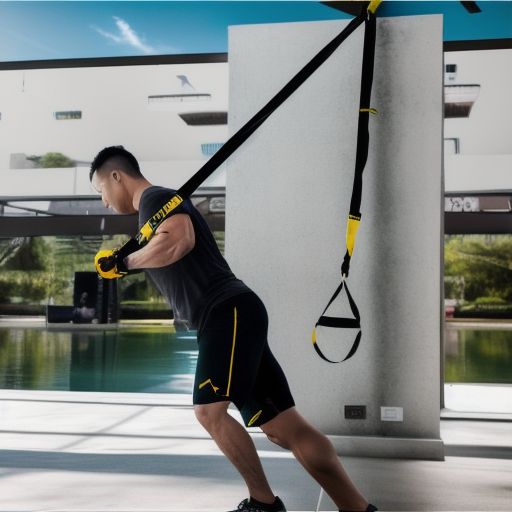
- Grasp one handle with one hand and face away from the anchor point.
- Walk your feet back until your body is at an angle.
- With your weight resting on your toes and your arms fully extended, perform TRX push-up on one hand.
Pro tip: In TRX single arm push-up, it is better to put one foot at the front and the other at the back. It gives more freedom of movement and allows a twisting move from hips level. In TRX single arm pushup when the arm reaches its extended position, twist your head and torso towards that shoulder and complete a full range of motion. Advanced trainees may add this technique to the standard TRX chest press and perform a full range of motion with one arm at a time. Contrary to that, if you need more control and stability in this exercise, also to prevent rotation of torso, position your feet wider apart than a regular TRX chest press.
The TRX Single Arm Push-up, also known as TRX single arm chest press, is a very challenging exercise requiring great strength, stability, and balance. It is essential to start with the basics and work your way up gradually to avoid injury. Beginners may want to start with a standard push-up, gradually building up to the single-arm version when they feel comfortable and confident with their technique.
3. TRX Chest Fly
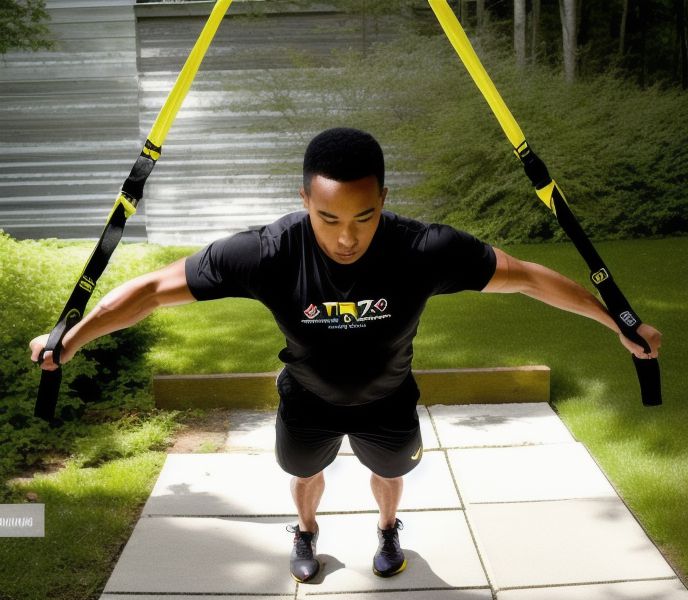
Body positioning in TRX chest fly is similar to TRX push-up. In TRX chest fly arms remain extended and because of that, according to the law of lever, chest muscle has to try harder to move the same amount of weight. Other than that, involvement of the tricep and shoulder muscles is minimal. Therefore, in TRX chest fly, angle of body is less steep compared to TRX chest press. Perform in 2–3 sets of 10–15 repetitions.
To learn about adjusting the resistance in bodyweight training with distance from pivot study, calisthenics vs weight training.
- Hold handles with both hands and extended arms in front of you.
- Find your starting position and appropriate angle of body.
- Hold a neutral hand position with palms facing each other.
- Slowly open your arms until you fully extend your chest muscles while slightly bending your elbows.
- Start the flexion phase by bringing hands close to each other and touch each other.
Standard hand position in TRX chest fly in neutral or overhand grip in which palms face each other. Nevertheless, we can add variation to this exercise by twisting hands into pronated grip as they get close to each other.
Pro-tip: Elbows are not locked, and arms should be in curved form when they are wide open. This prevents harmful pressure on elbow joints. However, as hands get close to each other, straighten your elbows so that you can perform a full range of motion with your chest muscles. If your elbows remain bent during the flexion phase, hands touch each other while the elbows are still wide apart. This position prevents your chest muscle from going through a full range of motion.
We can perform TRX chest fly with double anchor or single anchor point.
TRX Chest Fly to Chest Press
We can also combine TRX chest fly and TRX chest press in one exercise. TRX chest fly to chest press is in fact an eccentric chest fly exercise that uses TRX chest press for the positive phase of movement. The only change in this exercises is shifting arm position from extended to 90 degree and vice versa.
- Perform chest fly during the extension phase at slow pace.
- Bend elbows to 90 degrees.
- Perform TRX chest press for the flexion phase.
TRX Elbow Chest Fly
In TRX elbow chest fly instead of holding handles, we place forearms in foot cradles. The place of foot straps should be close to the elbows to avoid putting weight on triceps. Subsequently, arms will open from elbow level.
We can do TRX elbow chest fly both with single and double anchor points, but the main form of this TRX chest exercise is with double anchor point. Putting anchor points wide apart makes the exercise more challenging, especially when the elbows get closer to each other.
We can do TRX elbow chest fly with single arm. For single arm TRX elbow chest fly, put only one forearm in the foot cradle and face away from anchor point. Putting one leg in the front allows a better twisting move from hips level. This extra twisting move allows a complete range of motion in this exercise. Obviously, for this variation we need single anchor point.
Position of forearms in foot cradles and movement can rub forearm skin against straps. In order to prevent skin chafing, you can wear arm sleeves that protect elbows and parts of the forearm against the strap.
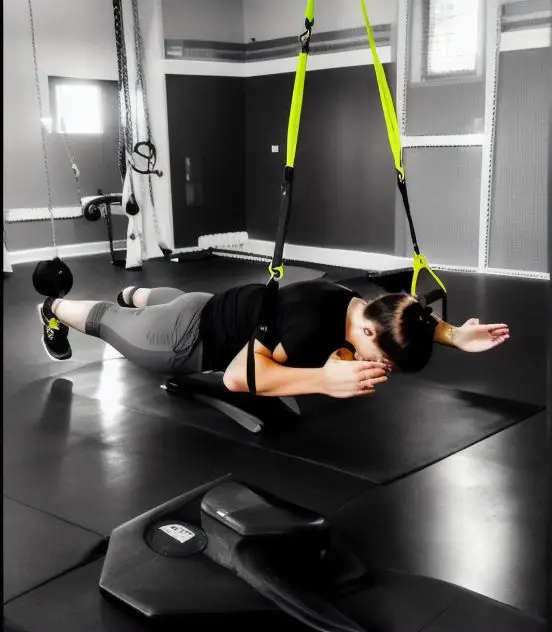
4. TRX Clock Press
TRX clock press is also known by other names such as TRX archer push-up or TRX chest press fly combo. Its name indicates that it’s a combination of TRX chest press and fly. How to do TRX clock press:
- Starting position is similar to TRX push-up with both hands straight.
- Start the descending phase with one arm getting bent from the elbow while the other arm performs a fly movement.
- Once handles reach chest level, push back your body to the initial position.
- Alternate press hand and fly hand.
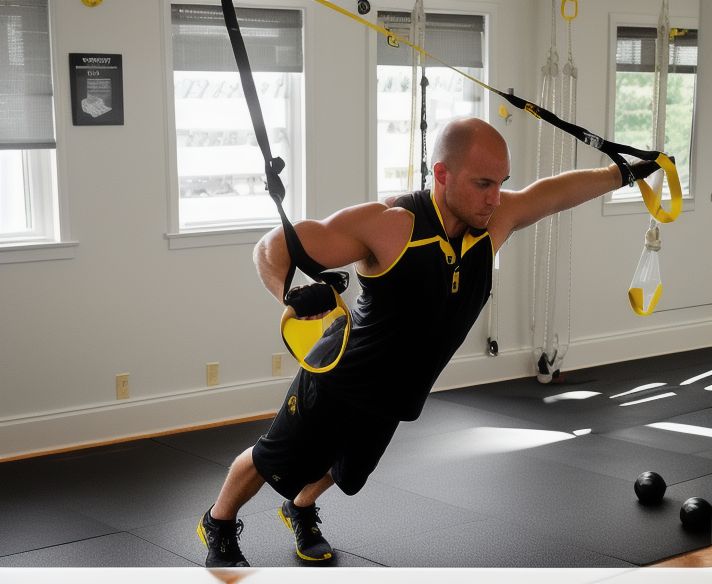
This is called TRX clock press because the fly arm points to different clock positions. The standard of this movement is when the fly hand points to 3 or the opposite hand at 9 o’clock. Other variations occur when the fly hand points to other clock numbers, such as 10 or 2 o’clock.
Take note that by changing clock position, we engage chest muscles at different angles or even engage other muscle groups. Another variation of this exercise is changing the clock position of the fly hand at each rep without alternating fly and chest hands. For the next set, alternate fly and chest hands.
A common mistake in executing TRX clock press is when someone does a TRX chest press and then extends one hand for the fly. This move engages the forearm muscle of the fly hand. Perform both fly and press actions simultaneously.
5. TRX Spiderman Push-up
- Place both hands on the ground. They are shoulder width apart and in push-up position.
- Put one foot in TRX foot cradle.
- As you lower your body during the push-up, bend the other leg towards the side and bring the knee close to the elbow.
- Start the lifting phase of push-up while simultaneously straightening the bent knee into its initial position.
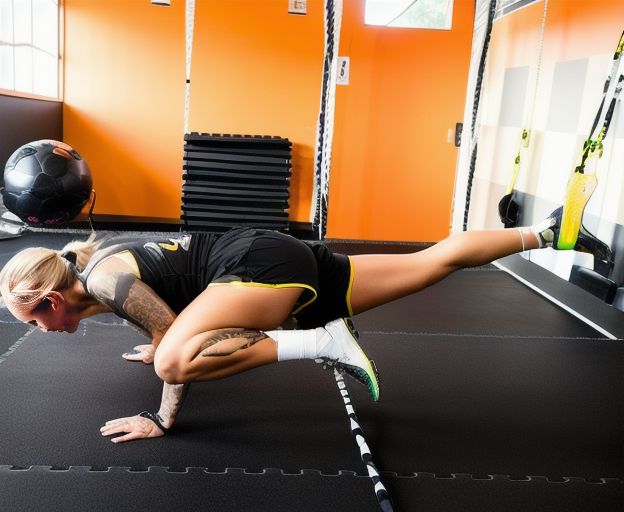
3 Levels of Progression in TRX Spiderman Push-up
In this TRX chest exercise, there are three variations that progress as per difficulty. The first variation is the easiest, and then it becomes more difficult.
- The bending leg is firstly on the ground, and when you bring the knee close to the elbow, you put your toes on the ground again.
- The bending leg is lifted up close to the other leg, and when you bring your knee close to the elbow, put your toes on the ground.
- Keep your bending leg off the ground all the time; both initially and when the knee gets close to the elbow.
In TRX spiderman push-up there is always one foot inside the foot cradle. However, for the third variation it is possible to have both feet inside foot cradles. Only lift the bending leg’s weight off the loop when it gets close to the elbow and then do the push-up.
6. TRX Upper Chest Exercises
The TRX upper chest exercises primarily targets the upper portion of the pectoralis major muscle, which is responsible for shoulder flexion and horizontal adduction of the arm.
Angles between arms and torso determine which parts of the pectoralis major muscle are the target of the exercise. For TRX upper chest exercises, we must adjust body slope and anchor point height in a way to place hands above chest level when they are extended.
Consider a standard TRX chest press with arms vertical to torso. At this position, if we slightly bend the upper body from waist level, the angle between arms and torso goes wider, and we can target upper chest muscles.
In other words, at the start of TRX upper chest exercise, bend your upper body and find a suitable angle. Maintain this angle throughout the exercise. This way, we can perform TRX chest press, chest fly, or other variations for the upper chest.
TRX Inverted Push-up
One more way to target upper chest muscles with TRX is TRX decline push-up. It is also called TRX inverted push-up or TRX reverse push-up.
The TRX inverted push-up is an advanced upper chest exercise that requires a good amount of upper body strength and control. It targets the chest, shoulders, triceps and also engages the core and stabilizer muscles in the body.
To perform the TRX inverted push-up, start by facing down towards the ground with your feet in the TRX straps and your hands placed shoulder-width apart on the floor. Your arms are straight, and feet are at a higher level than your chest.
We can put one foot inside a foot cradle and lay the other foot above that one. This position makes it easier to adjust body positioning.
Next, lower your chest towards the ground by bending your elbows. Pause briefly at the bottom of the movement, and then push yourself back up to the starting position; fully extending your arms.
Maintaining proper form throughout the movement is vital to avoid injury; avoid letting your hips sag. Ensure you don’t pike during the exercise to help lift your weight. However, you may pike intentionally as an intelligent weight technique to assist with the move if it is challenging for your strength level.
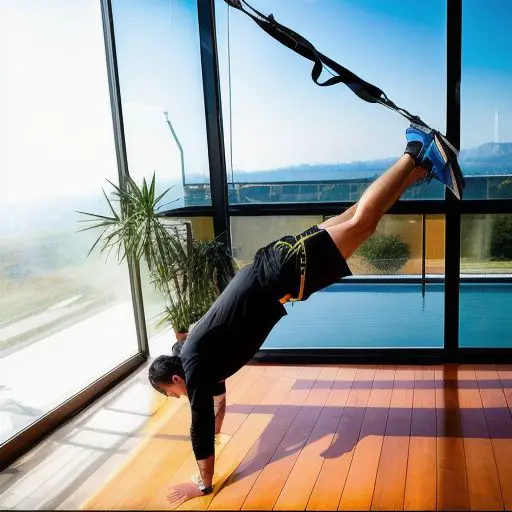
7. TRX Lower Chest Exercises
For TRX lower chest exercise, arms should be lower than chest level, and so the angle between arms and torso is less than 90 degrees. To achieve this angle, your body positioning should be right below the TRX anchor point, and your torso should be slightly inclined forward. This way, when you hold TRX handles, your hands are pointed downwards, targeting the lower portion of the pectoralis major muscle.
TRX Chest Dips
- Body position is right below the anchor point.
- Hold both handles and lean slightly forward.
- Slowly bend elbows and descend.
- Push your body upwards to the initial position.
Using double anchor point instead of single anchor point is more suitable for TRX chest dip. If the exercise is too hard for your strength level, put your feet on the ground and assist with the exercise.
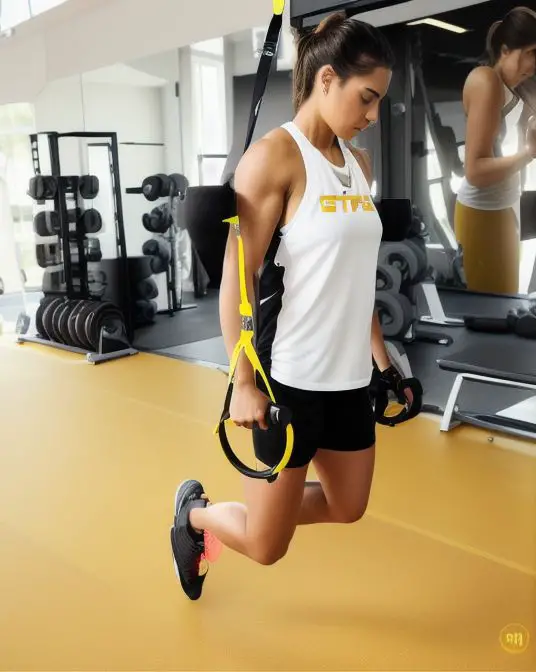
To have more control over the exercise and use the intelligent weight technique, step one foot forward and bend your knees as you descend. This way, you keep your body angle throughout each rep and also assist the exercise using your leg muscles.
You can also change grip type to overhand or hammer grip, or even twist from one to another to execute different exercise variations.
TRX chest dip primarily works the chest muscles, along with the shoulders and triceps, and it differs slightly from TRX triceps dip.
Changing Training Systems to Create Variety in TRX Chest Exercises
So far, we have explored creating variations of TRX chest workouts using different hand grips and body positions. Another way to create variation is implementing different training systems in the routine. As usual, we adjust the amount of weight by changing body position or using intelligent weight technique.
TRX pyramid workout incorporates bodyweight pyramid workout into TRX system. There are various pyramid methods we can apply to TRX chest exercises, such as ascending pyramid training, reverse pyramid training, diamond pyramid training.
TRX drop set is very similar to TRX reverse pyramid workout, except drop set is one long set, and we reduce weights within one set without rest. To perform TRX drop set for chest:
- Start at an angle where you can do 8 reps at max.
- Reduce the weight by 20 percent and do 10–12 reps.
- Reduce the weight again and do 10–15 reps.
- Repeat this drop until you cannot do another rep.
TRX superset is a high-intensity training method that involves doing two exercises back to back with no rest between the two. For example, you can pair TRX rows with TRX push-ups. Perform 12–15 reps of TRX Rows, immediately followed by 12–15 reps of TRX Push-Ups, and then rest for 30–60 seconds. Repeat for a total of 3–4 sets. TRX combo exercises are suitable choices for a TRX superset workout. A few examples are TRX chest and tricep exercises, Trx chest and back workout, and TRX chest press to standing fallout.
TRX giant set is very similar to TRX superset, yet it involves at least 4 exercises back to back. A giant set for chest:
- TRX push up
- TRX upper chest push up
- TRX lower chest push up
- TRX clock press
- full rest
Using eccentric system in chest workouts such as TRX eccentric chest fly or eccentric push-up emphasizes the negative phase of the movement. A typical way to implement the eccentric system is to overload the muscle during the negative phase and assist with the move during the positive phase.
German Volume Training (GVT) is a high-volume, intense training program that involves performing 10 sets of 10 reps for a single exercise. For TRX chest press, you can do 10 sets of 10 reps with 60 seconds of rest between sets. Incorporating GVT into a training program requires some knowledge of designing training plans.
TRX plyo push-up applies plyometric training into TRX chest exercises. Basic are the same as standard TRX chest press with feet in the straps and hands on the ground. The only difference is that during the extension phase, there is a hopping motion. So, for a short time both hands are detached from the floor.
Suspension fly hold or TRX fly hold applies isometric contraction into TRX chest exercise. Position your body in TRX Chest fly with arms extended at both sides and hold in that position for a few seconds.
Please note that implementing some of these training methods can make the exercises extremely challenging, which is not suitable for beginners. Moreover, not every training system is suitable for the purpose of hypertrophy. So, implement training systems based on the your goal and overall training plan.
You can find information about these training methods in TRX Hypertrophy Sets with Different Training Systems.
Combo TRX Chest exercises
TRX chest combo exercises are a great way to target your chest muscles and get a full-body workout at the same time. Sometimes we combine two different chest workouts, and sometimes chest muscles are paired with another muscle group. A few examples:
TRX Atomic Pushup is an exercise combo that primarily targets both the chest and abs as it combines the TRX push up and TRX crunch.
TRX Atomic Oblique Push-up is a challenging variation of the traditional push-up that targets your obliques, chest, triceps, and shoulders.
TRX pike push up targets your chest, shoulders, triceps, and core.
Read the post about TRX atomic push-up and its variations.
TRX chest exercises can also be combined with back exercises to make a time efficient, full-body training session. Here you can read about TRX back exercises.
